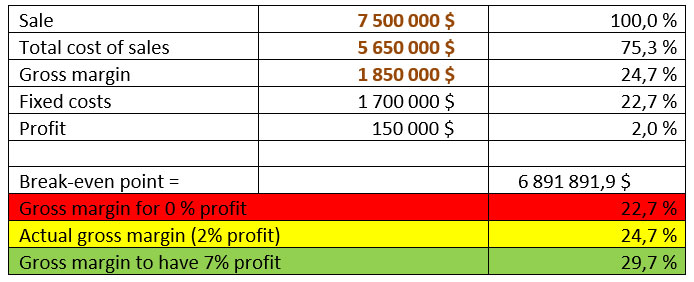Case Study
Improving profitability in the construction sector
To demonstrate how our approach is applied, here is a real case study for a company that operates in the construction industry.
Construction sector: case study
Our client contacted us with one goal in mind: to improve profitability. Following a combined effort, we were able to identify which of their numerous operational elements had a major impact on their profitability. Using this as a starting point, we implemented a series of actions that had short and medium-term impacts on the client’s team.
Company analysis and evaluation
Our first instinct was to analyze the company’s data in order to pinpoint the main pitfalls. Various tables were then assembled that allowed us to evaluate their operational effectiveness and draw conclusions that were used to develop measures to optimize their work management.
Developing a key indicator: profitability per project
The IDEA Strategies team started by studying data on the actual profitability of each project. As a guideline, let us keep in mind that construction sector profitability depends on four factors:
- Is the project estimation accurate?
- Was the project execution in line with the estimate and done effectively?
- Was the project profit margin (MB: planned) sufficient to cover its share of fixed costs?
- Have the extras and contract deviations been identified and billed accordingly?
We therefore compiled a table listing the important information: profitability by project type, profitability by customer, profitability by valuation and by construction site foreman or project manager.
Financial statement analysis: establishing the break-even point
By studying the financial statements, we were able to determine the company’s break-even point, which is the average percentage of gross margin that it must achieve to be profitable.
Construction company: measures developed to respond to the issues
With this data, we were able to identify the weak links in the company and develop adequate and realistic solutions in collaboration with the management team. We therefore focused our efforts on the value chain and improving teamwork.
Estimation accuracy:
- Implementation of a single estimate method in the company;
- Standardization of estimation methods;
- Identification of the most and least profitable estimators;
- Transfer of best practices between estimators to ensure that everyone has the required accuracy.
Work execution:
- Have a team meeting during or at the end of the contract: estimation/foreman/project manager to clearly identify cost overruns;
- Based on the commonalities between profitable and unprofitable projects, we were able to draw up a list of concrete daily actions to improve execution in specific cases. The management then reserves a fixed and significant time to ensure the implementation of these “control routines”.
Planned profit of the project:
- Sometimes a project can be well estimated, well executed and still not very profitable. This indicates that they have given in to the temptation of seeking an unprofitable business volume. Understanding the company’s break-even point makes it possible to set clear guidelines on the profitability required for each project. The management team can then assess whether an unprofitable project is worth accepting.
Tracking extras:
- Establishment of a clear and simple procedure to rapidly document extras;
- Introduction of a weekly extras review routine to recover a large portion of the associated costs and profits.
IDEA Strategies:
proven resultS
These measures allowed the company to establish more accurate price and project duration estimates while maximizing profitability. They have regained control of unexpected events and extras and can, with the key indicators that were provided, recognize the most urgent situations at a glance and take action.
The IDEA Strategies team develops your strengths alongside you, while solidifying certain critical points in your chain of operations. Contact us today to discuss how we can help your business maximize its bottom line and reach its full potential.


